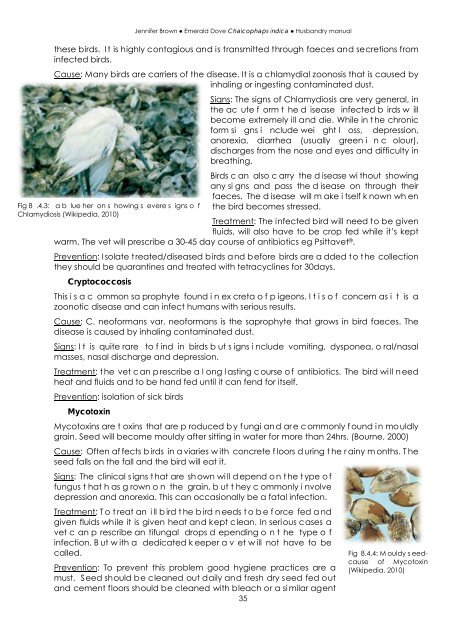Emerald Dove Husbandry Manual - Nswfmpa.org
Emerald Dove Husbandry Manual - Nswfmpa.org
Emerald Dove Husbandry Manual - Nswfmpa.org
Create successful ePaper yourself
Turn your PDF publications into a flip-book with our unique Google optimized e-Paper software.
Jennifer Brown ● <strong>Emerald</strong> <strong>Dove</strong> Chalcophaps indica ● <strong>Husbandry</strong> manual<br />
these birds. It is highly contagious and is transmitted through faeces and secretions from<br />
infected birds.<br />
Cause: Many birds are carriers of the disease. It is a chlamydial zoonosis that is caused by<br />
inhaling or ingesting contaminated dust.<br />
Fig 8 .4.3: a b lue her on s howing s evere s igns o f<br />
Chlamydiosis (Wikipedia, 2010)<br />
Signs: The signs of Chlamydiosis are very general, in<br />
the ac ute f orm t he d isease infected b irds w ill<br />
become extremely ill and die. While in t he chronic<br />
form si gns i nclude wei ght l oss, depression,<br />
anorexia, diarrhea (usually green i n c olour),<br />
discharges from the nose and eyes and difficulty in<br />
breathing.<br />
Birds c an also c arry the d isease wi thout showing<br />
any si gns and pass the d isease on through their<br />
faeces. The d isease will m ake i tself k nown wh en<br />
the bird becomes stressed.<br />
Treatment: The infected bird will need to be given<br />
fluids, will also have to be crop fed while it’s kept<br />
warm. The vet will prescribe a 30-45 day course of antibiotics eg Psittavet ® .<br />
Prevention: Isolate t reated/diseased birds a nd before birds are a dded t o t he collection<br />
they should be quarantines and treated with tetracyclines for 30days.<br />
Cryptococcosis<br />
This i s a c ommon sa prophyte found i n ex creta o f p igeons. I t i s o f concern as i t is a<br />
zoonotic disease and can infect humans with serious results.<br />
Cause: C. neoformans var. neoformans is the saprophyte that grows in bird faeces. The<br />
disease is caused by inhaling contaminated dust.<br />
Signs: I t is quite rare to f ind in birds b ut s igns i nclude vomiting, dysponea, o ral/nasal<br />
masses, nasal discharge and depression.<br />
Treatment: t he vet c an p rescribe a l ong l asting c ourse o f antibiotics. The bird wi ll n eed<br />
heat and fluids and to be hand fed until it can fend for itself.<br />
Prevention: isolation of sick birds<br />
Mycotoxin<br />
Mycotoxins are t oxins that are p roduced b y f ungi an d ar e c ommonly f ound i n mo uldly<br />
grain. Seed will become mouldy after sitting in water for more than 24hrs. (Bourne, 2000)<br />
Cause: Often af fects b irds in a viaries w ith concrete f loors d uring t he r ainy m onths. T he<br />
seed falls on the fall and the bird will eat it.<br />
Signs: The clinical s igns t hat are sh own wi ll d epend o n t he t ype o f<br />
fungus t hat h as g rown o n the grain, b ut t hey c ommonly i nvolve<br />
depression and anorexia. This can occasionally be a fatal infection.<br />
Treatment: T o t reat an i ll b ird t he b ird n eeds t o b e f orce fed a nd<br />
given fluids while it is given heat and kept clean. In serious cases a<br />
vet c an p rescribe an tifungal drops d epending o n t he type o f<br />
infection. B ut w ith a dedicated k eeper a v et w ill not have to be<br />
called.<br />
Prevention: To prevent this problem good hygiene practices are a<br />
must. Seed should be cleaned out daily and fresh dry seed fed out<br />
and cement floors should be cleaned with bleach or a si milar agent<br />
35<br />
Fig 8.4.4: M ouldy s eedcause<br />
of Mycotoxin<br />
(Wikipedia, 2010)

















